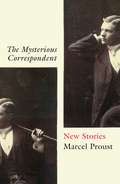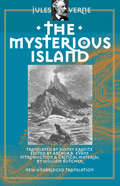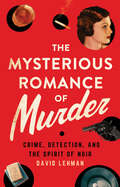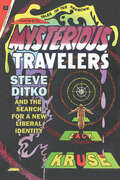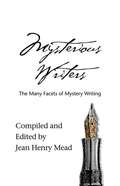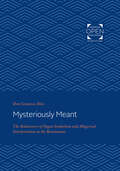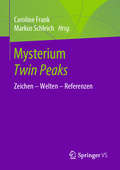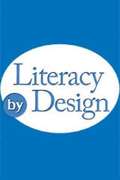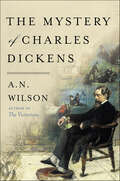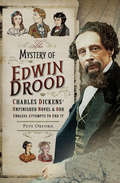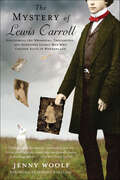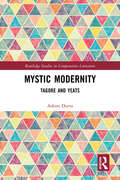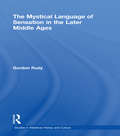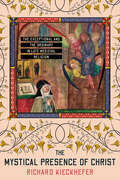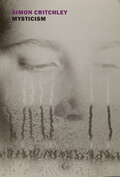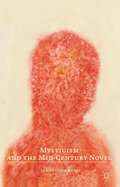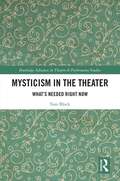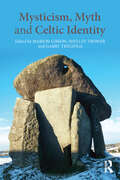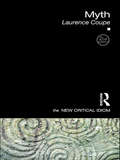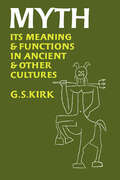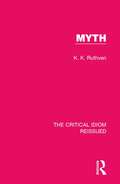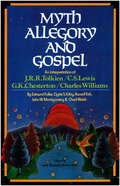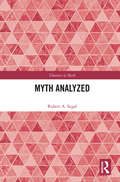- Table View
- List View
The Mysterious Correspondent: New Stories
by Marcel Proust'Startlingly audacious.' Literary Review New writing from the literary master Throughout Proust&’s life, nine of his short stories remained unseen – the writer never even spoke of them. Perhaps he was not ready to share the early themes he was nurturing for his masterpiece, In Search of Lost Time. Or perhaps, in dealing directly with gay desire, they were too audacious – too near to life – for the censorious society of the time. In these stories, published in English for the first time, we find an intimate portrait of a young author full of darkness, complexity and melancholy, longing to reveal himself to the world.
The Mysterious Island: The Secret Of The Island (Early Classics of Science Fiction)
by Jules VerneAt a time when Verne is making a comeback in the US as a mainstream literary figure, Wesleyan is pleased to publish a new translation of one of his best-known novels, The Mysterious Island. Although several editions under the same title are in print, most reproduce a bowdlerized nineteenth-century translation which changes the names of the characters, omits several important scenes, and ideologically censors Verne's original text.The Mysterious Island was published in 1874, and it is one of Verne's longest novels. The plot depicts a group of men who have become castaways stranded on an island in the Pacific during the American Civil War. The novel describes their attempts not only to survive but also, with the aid of the scientific and technological know-how, to rebuild their world from the meager resources of the island. At the end, however, it is realized that Captain Nemo, from Twenty Thousand Leagues Under the Sea, has secretly been helping the settlers. A marvelous adventure story, The Mysterious Island is also notable for its modern retelling of the utopian deserted-island myth, with repeated echoes of Robinson Crusoe and the Swiss Family Robinson. This Wesleyan edition features notes, appendices and an introduction by Verne scholar William Butcher, as well as reproductions of the illustrations from the original French edition.
The Mysterious Romance of Murder: Crime, Detection, and the Spirit of Noir
by David LehmanFrom Sherlock Holmes to Sam Spade; Nick and Nora Charles to Nero Wolfe and Archie Goodwin; Harry Lime to Gilda, Madeleine Elster, and other femmes fatales—crime and crime solving in fiction and film captivate us. Why do we keep returning to Agatha Christie's ingenious puzzles and Raymond Chandler's hard-boiled murder mysteries? What do spy thrillers teach us, and what accounts for the renewed popularity of morally ambiguous noirs? In The Mysterious Romance of Murder, the poet and critic David Lehman explores a wide variety of outstanding books and movies—some famous (The Maltese Falcon, Double Indemnity), some known mainly to aficionados—with style, wit, and passion.Lehman revisits the smoke-filled jazz clubs from the classic noir films of the 1940s, the iconic set pieces that defined Hitchcock's America, the interwar intrigue of Eric Ambler's best fictions, and the intensity of attraction between Humphrey Bogart and Lauren Bacall, Robert Mitchum and Jane Greer, Cary Grant and Ingrid Bergman. He also considers the evocative elements of noir—cigarettes, cocktails, wisecracks, and jazz standards—and offers five original noir poems (including a pantoum inspired by the 1944 film Laura) and ironic astrological profiles of Barbara Stanwyck, Marlene Dietrich, and Graham Greene. Written by a connoisseur with an uncanny feel for the language and mood of mystery, espionage, and noir, The Mysterious Romance of Murder will delight fans of the genre and newcomers alike.
Mysterious Travelers: Steve Ditko and the Search for a New Liberal Identity (Great Comics Artists Series)
by Zack KruseSteve Ditko (1927–2018) is one of the most important contributors to American comic books. As the cocreator of Spider-Man and sole creator of Doctor Strange, Ditko made an indelible mark on American popular culture. Mysterious Travelers: Steve Ditko and the Search for a New Liberal Identity resets the conversation about his heady and powerful work. Always inward facing, Ditko’s narratives employed superhero and supernatural fantasy in the service of self-examination, and with characters like the Question, Mr. A, and Static, Ditko turned ordinary superhero comics into philosophic treatises. Many of Ditko’s philosophy-driven comics show a clear debt to ideas found in Ayn Rand’s Objectivism. Unfortunately, readers often reduce Ditko’s work to a mouthpiece for Rand’s vision. Mysterious Travelers unsettles this notion. In this book, Zack Kruse argues that Ditko’s philosophy draws on a complicated network of ideas that is best understood as mystic liberalism. Although Ditko is not the originator of mystic liberalism, his comics provide a unique window into how such an ideology operates in popular media. Examining selections of Ditko’s output from 1953 to 1986, Kruse demonstrates how Ditko’s comics provide insight into a unique strand of American thought that has had a lasting impact.
Mysterious Writers
by Larry Karp Jean Henry Mead Mary Reed Beverle Graves Myers Tim Maleeny Eric MayerMystery novels are published in a number of subgenres to satisfy the tastes of every reader. Not only do we have the traditional mystery--also known as the cozy--there are historicals, suspense and thriller novels, crime, police procedurals, private eyes and senior sleuths (also known as "geezer lit"). Then there are medical thrillers, romantic suspense as well as science fiction mysteries and the niche novels that cover endless subjects. The mystery writers interviewed here have written articles about various aspects of publishing, including writing techniques, marketing, promotional advice and their opinions on the current state of the publishing industry. Carolyn Hart, bestselling author of the Henrie O and Death on Demand series, talks about her new protagonist, Bailey Ruth Raeburn, who returns to earth as a ghost to anonymously solve mysteries. Jeffrey Deaver's varied careers prepared him to write insightful as well as thrilling novels, John Gilstrap explains why some bestselling novelists hold down fulltime jobs, and Rick Mofina provides sixteen great tips for writing thriller novels. A number of Canadian and UK authors share their publishing views as well as comparing books from their own countries with those of the U.S. suspense novelist Paul Johnston writes from his native Scotland as well as his home in Greece while Tim Hallinan divides his time between Thailand, Cambodia, and southern California, writing much of his work in Bangkok cafés. Gillian Phillip writes YA mystery novels from Barbados and her native Scottish highlands, and international airline pilot Mark W. Danielson composes his suspense novels during layovers in various parts of the world, while S. J. Bolton thrills us with snakes and other creepy creatures in and from the British Isles. English native Carola Dunn writes historical mysteries about her countrymen as does Rhys Bowen, who writes about historical English royals. Other historical novelists include Larry Karp, who provides us with the history of Ragtime music and the people who made the genre popular during its heyday and Beverle Graves Myers delves into operatic mysteries set in 18th century Venice. The work of several writing teams inhabits this book, including Eric Mayer and Mary Reed, who pen historical mysteries. Mark and Charlotte Phillips write suspense novels, and Morgan St. James and her sister Phyllice Bradner collaborate on humorous mysteries. Jeff Cohen, Tim Maleeny, and Carl Brookins also add humor to their mysterious plots, so prepare to laugh when you open their books. There are police procedurals, medical thrillers and romantic suspense novelists represented here as well as niche mysteries designed for readers who love dogs, scrapbooking, zoos, the Arizona desert, space shuttles, weight-loss clinics, actors, designer gift baskets and other specialty subjects. Nonfiction books about the mystery genre round out this eclectic collection with Edgar winner E.J. Warner, Agatha winner Chris Roerden, Lee Lofland, Jeffrey Marks, and small press publishers Vivian Zabel and Tony Burton. The advice offered here is invaluable to fledgling writers, so pull up a comfortable chair and begin the mysterious tour of nearly every subgenre.
Mysteriously Meant: The Rediscovery of Pagan Symbolism and Allegorical Interpretation in the Renaissance
by Don Cameron AllenOriginally published in 1971. In Mysteriously Meant, Professor Allen maps the intellectual landscape of the Renaissance as he explains the discovery of an allegorical interpretation of Greek, Latin, and finally Egyptian myths and the effect this discovery had on the development of modern attitudes toward myth. He believes that to understand Renaissance literature one must understand the interpretations of classical myth known to the sixteenth and seventeenth centuries. In unraveling the elusive strands of myth, allegory, and symbol from the fabric of Renaissance literature such as Milton's Paradise Lost, Allen is a helpful guide. His discussion of Renaissance authors is as authoritative as it is inclusive. His empathy with the scholars of the Renaissance keeps his discussion lively—a witty study of interpreters of mythography from the past.
Mysterium Twin Peaks: Zeichen – Welten – Referenzen
by Caroline Frank Markus SchleichDer Sammelband bringt verschiedene Zugänge und Kontexte zu Twin Peaks zusammen und greift dabei auch die besonderen produktions- und rezeptionsästhetischen Spezifika der Serie auf. Das Spektrum der Beiträge umfasst ganz unterschiedliche Themenbereiche: Genremix, Transaktualität, komplexe narrative Strukturen, Traum und Traumhaftigkeit, Geschlechts- und Identitätskonzepte, extremer Fankult, visuelle Ästhetik, akustische Dimensionen, postmoderne Verweiskultur und nicht zuletzt die Frage danach, welche anderen Quality TV-Serien durch Twin Peaks erst möglich wurden.
Mystery at Marin Marsh (Rigby Literacy by Design)
by Denise M. Jordan Carol StutzNIMAC-sourced textbook
The Mystery of Charles Dickens
by A.N. WilsonWinner of the Plutarch Award for Best BiographyA lively and insightful biographical celebration of the imaginative genius of Charles Dickens, published in commemoration of the 150th anniversary of his death.Charles Dickens was a superb public performer, a great orator and one of the most famous of the Eminent Victorians. Slight of build, with a frenzied, hyper-energetic personality, Dickens looked much older than his fifty-eight years when he died—an occasion marked by a crowded funeral at Westminster Abbey, despite his waking wishes for a small affair. Experiencing the worst and best of life during the Victorian Age, Dickens was not merely the conduit through whom some of the most beloved characters in literature came into the world. He was one of them.Filled with the twists, pathos, and unusual characters that sprang from this novelist’s extraordinary imagination, The Mystery of Charles Dickens looks back from the legendary writer’s death to recall the key events in his life. In doing so, he seeks to understand Dickens’ creative genius and enduring popularity. Following his life from cradle to grave, it becomes clear that Dickens’s fiction drew from his life—a fact he acknowledged. Like Oliver Twist, Dickens suffered a wretched childhood, then grew up to become not only a respectable gentleman but an artist of prodigious popularity. Dickens knew firsthand the poverty and pain his characters endured, including the scandal of a failed marriage. Going beyond standard narrative biography, A. N. Wilson brilliantly revisits the wellspring of Dickens’s vast and wild imagination, to reveal at long last why his novels captured the hearts of nineteenth century readers—and why they continue to resonate today. The Mystery of Charles Dickens is illustrated with 30 black-and-white images.
The Mystery of Edwin Drood: Charles Dickens' Unfinished Novel and Our Endless Attempts to End It
by Pete OrfordA tantalizing tour through a true bibliomystery that will “get people talking about one of literature’s greatest enigmas” (KentOnline). When Dickens died on June 9, 1870, he was halfway through writing his last book, The Mystery of Edwin Drood. Since that time, hundreds of academics, fans, authors, and playwrights have presented their own conclusion to this literary puzzler. Step into 150 years of Dickensian speculation to see how our attitudes both to Dickens and his mystifying last work have developed. At first, enterprising authors tried to cash in on an opportunity to finish Dickens’ book. Dogged attempts of early twentieth-century detectives proved Drood to be the greatest mystery of all time. Earnest academics of the mid-century reinvented Dickens as a modernist writer. Today, the glorious irreverence of modern bibliophiles reveals just how far people will go in their quest to find an ending worthy of Dickens. Whether you are a die-hard Drood fan or new to the controversy, Dickens scholar Pete Orford guides readers through the tangled web of theories and counter-theories surrounding this great literary riddle. From novels to websites; musicals to public trials; and academic tomes to erotic fiction, one thing is certain: there is no end to the inventiveness with which we redefine Dickens’ final story, and its enduring mystery.
The Mystery of Lewis Carroll: Discovering the Whimsical, Thoughtful, and Sometimes Lonely Man Who Created Alice in Wonderland
by Jenny WoolfA new biography of Lewis Carroll, just in time for the release of Tim Burton's all-star Alice in Wonderland Lewis Carroll was brilliant, secretive and self contradictory. He reveled in double meanings and puzzles, in his fiction and his life. Jenny Woolf's The Mystery of Lewis Carroll shines a new light on the creator of Alice In Wonderland and brings to life this fascinating, but sometimes exasperating human being whom some have tried to hide. Using rarely-seen and recently discovered sources, such as Carroll's accounts ledger and unpublished correspondence with the "real" Alice's family, Woolf sets Lewis Carroll firmly in the context of the English Victorian age and answers many intriguing questions about the man who wrote the Alice books, such as: • Was it Alice or her older sister that caused him to break with the Liddell family? • How true is the gossip about pedophilia and certain adult women that followed him? • How true is the "romantic secret" which many think ruined Carroll's personal life? • Who caused Carroll major financial trouble and why did Carroll successfully conceal that person's identity and actions? Woolf answers these and other questions to bring readers yet another look at one of the most elusive English writers the world has known.
The Mystic Ark
by Conrad RudolphIn this book, Conrad Rudolph studies and reconstructs Hugh of St. Victor's forty-two-page written work, The Mystic Ark, which describes the medieval painting of the same name. In medieval written sources, works of art are not often referred to, let alone described in any detail. Almost completely ignored by art historians because of the immense difficulty of its text, Hugh of Saint Victor's Mystic Ark (c. 1125-1130) is among the most unusual sources we have for an understanding of medieval artistic culture. Depicting all time, all space, all matter, all human history, and all spiritual striving, this highly polemical painting deals with a series of cultural issues crucial in the education of society's elite during one of the great periods of intellectual change in Western history.
Mystic Modernity: Tagore and Yeats (Routledge Studies in Comparative Literature)
by Ashim DuttaThis is a transnational and bilingual investigation of the cross-fertilisation of mystical religiosity and modern poetical imagination in the works of the Bengali poet Rabindranath Tagore and the Irish poet W. B. Yeats. The book demonstrates how their commitments to transnational mysticism deeply form and inform the modernist literary projects of these poets as well as their understanding of cultural modernity. Although its primary interest lies in their poetry and poetics, the monograph also includes some of their relevant prose works. This study begins with a close look at and around the phase of 1912-1913, when Yeats and Tagore met over the collection of the latter’s English translations of his spiritual verses, Gitanjali, and took mutual interests in each other’s works and cultural significances. The monograph then expands on both sides of that phase, selectively covering the whole career of the poets in its exploration of their parallel mystic-modern cultural-poetical projects.
The Mystical Language of Sensation in the Later Middle Ages (Studies in Medieval History and Culture #14)
by Gordon RudyFirst Published in 2002. This book is about the way medieval authors wrote about union with God and how they used language that refers to the senses to articulate their ideas about how a person can be one with God. Rudy argues that such explicit concepts of the spiritual senses are not sharply distinct from the ideas implicit in broader usage of sensory language in theological writings. These ideas are significant in the history of Christian mysticism, because language that refers to the senses bears directly on several ideas that are central to ideas about union with God.
The Mystical Presence of Christ: The Exceptional and the Ordinary in Late Medieval Religion (Medieval Societies, Religions, and Cultures)
by Richard KieckheferThe Mystical Presence of Christ investigates the connections between exceptional experiences of Christ's presence and ordinary devotion to Christ in the late medieval West. Unsettling the notion that experiences of seeing Christ's figure or hearing Christ speak are simply exceptional events that happen at singular moments, Richard Kieckhefer reveals the entanglements between these experiences and those that occur through the imagery, language, and rituals of ordinary, everyday devotional culture.Kieckhefer begins his book by reconsidering the "who" and the "how" of Christ's mystical presence. He argues that Christ's humanity and divinity were equally important preconditions for encounters, both exceptional and ordinary, which Kieckhefer proposes as existing on a spectrum of experience that moves from presupposition to intuition and finally to perception. Kieckhefer then examines various contexts of Christ manifestations—during prayer, meditation, and liturgy, for example—with attention to gender dynamics and the relationship between saintly individuals and their hagiographers. Through penetrating discussions of a diverse set of texts and figures across the long fourteenth century (Angela of Foligno, the nuns of Helfta, Margery Kempe, Dorothea of Montau, Meister Eckhart, Henry Suso, and Walter Hilton, among others), Kieckhefer shows that seemingly exceptional manifestations of Christ were also embedded in ordinary religious experience.Wide-ranging in scope and groundbreaking in methodology, The Mystical Presence of Christ is a magisterial work that rethinks the interplay between the exceptional and the ordinary in the workings of late medieval religion.
The Mystical Science of the Soul
by Jessica A. BoonThe Mystical Science of the Soul explores the unexamined influence of medieval discourses of science and spirituality on recogimiento, the unique Spanish genre of recollection mysticism that served as the driving force behind the principal developments in Golden Age mysticism. Building on recent research in medieval optics, physiology, and memory in relation to the devotional practices of the late Middle Ages, Jessica A. Boon probes the implications of an 'embodied soul' for the intellectual history of Spanish mysticism.Boon proposes a fundamental rereading of the key recogimiento text Subida del Monte Sión (1535/1538), which melds the traditionally distinct spiritual techniques of moral self-examination, Passion meditation, and negative theology into one cognitively adept path towards mystical union. She is also the first English-language scholar to treat the author of this influential work - the Renaissance physician Bernardino de Laredo, a pivotal figure in the transition from medieval to early modern spirituality on the Iberian peninsula and a source for Teresa of Avila's mystical language.
Mysticism
by Simon CritchleyA probing, inspiring exploration of mysticism not as religious practice but as a mode of experience and way of life by one of the most provocative philosophical thinkers of our time.Why mysticism? It has been called &“experience in its most intense form,&” and in his new book the philosopher Simon Critchley poses a simple question to the reader: Wouldn&’t you like to taste this intensity? Wouldn&’t you like to be lifted up and out of yourself into a sheer feeling of aliveness, both your life and those of the creatures that surround you? If so, it might be well worthwhile trying to learn what is meant by mysticism and how it can shift, elevate, and deepen the sense of our lives. Mysticism is not primarily a theoretical issue. It's not a question of religious belief but of felt experience and daily practice. A rough and ready definition of mysticism is that it is a way of systematically freeing yourself of your standard habits, your usual fancies and imaginings so as to see what is there and stand with what is there ecstatically. Mysticism is the practical possibility of the achievement of a fluid openness between thought and existence. This is a book about trying to get outside oneself, to lose oneself, while knowing that the self is not something that can ever be fully lost. It is also a book about Julian of Norwich, Anne Carson, Annie Dillard, T.S. Eliot, and Nick Cave. It shows how listening to music can be secular worship. It is a book full of learning, puzzlement, pleasure, and wonder. It opens the door to mysticism not as something unworldly and unimaginable, but as a way of life.
Mysticism and the Mid-Century Novel
by James ClementsThis book argues that many of the mid-twentieth century's significant novelists were united by a desire to return the increasingly interior novel to ethical engagement. They did not seek morality in society, politics or the individual will, but sought to unveil a transcendent Good by using techniques drawn from the canon of mystical literature
Mysticism in the Theater: What’s Needed Right Now (Routledge Advances in Theatre & Performance Studies)
by Tom BlockMysticism in the Theater introduces theater makers to the power and possibility of using historical mystical ideas to influence all aspects of a production. Historical mysticism represents ideas developed by recognized spiritual thinkers in all religions and time periods: individuals who stilled their ego, and perceived the unity of all, hidden within the apparent multiplicity of existence. This unique manner of spiritual inlay allows theatrical presentations to find the height of artistic expression: art at the intersection of our historical moment and the eternal. This study introduces theater makers to the history of mystical inspiration within performance work and develops strategies for inserting mystical ideas into their productions. The book ties this model into theatre’s history, as mystical ideas and quotes have been inserted into productions from Greek theatre through Shakespeare and into the present day. This book explores how teachings and ideas of specific historical mystical thinkers might influence all aspects of contemporary theatrical productions including writing, directing, acting, stagecraft/set design, lighting design, costume design, sound design, and choreography.
Mysticism, Myth and Celtic Identity
by Shelley Trower Marion Gibson Garry TregidgaMysticism, Myth and Celtic Identity explores how the mythical and mystical past informs national imaginations. Building on notions of invented tradition and myths of the nation, it looks at the power of narrative and fiction to shape identity, with particular reference to the British and Celtic contexts. The authors consider how aspects of the past are reinterpreted or reimagined in a variety of ways to give coherence to desired national groupings, or groups aspiring to nationhood and its ‘defence’. The coverage is unusually broad in its historical sweep, dealing with work from prehistory to the contemporary, with a particular emphasis on the period from the eighteenth century to the present. The subject matter includes notions of ancient deities, Druids, Celticity, the archaeological remains of pagan religions, traditional folk tales, racial and religious myths and ethnic politics, and the different types of returns and hauntings that can recycle these ideas in culture. Innovative and interdisciplinary, the scholarship in Mysticism, Myth and Celtic Identity is mainly literary but also geographical and historical and draws on religious studies, politics and the social sciences. Thus the collection offers a stimulatingly broad number of new viewpoints on a matter of great topical relevance: national identity and the politicization of its myths.
Myth (The New Critical Idiom)
by Laurence CoupeLaurence Coupe offers students a comprehensive overview of the development of myth, showing how mythic themes, structures and symbols persist in literature and entertainment today. This introductory volume: illustrates the relation between myth, culture and literature with discussions of poetry, fiction, film and popular song explores uses made of the term ‘myth’ within the fields of literary criticism, anthropology, cultural studies, feminism, Marxism and psychoanalysis discusses the association between modernism, postmodernism, myth and history familiarizes the reader with themes such as the dying god, the quest for the Grail, the relation between ‘chaos’ and ‘cosmos’, and the vision of the end of time demonstrates the growing importance of the green dimension of myth. Fully updated and revised in this new edition, Myth is both a concise introduction and a useful tool to students first approaching the topic, while also a valuable contribution to the study of myth.
Myth: Its Meaning and Functions in Ancient and Other Cultures (Sather Classical Lectures #40)
by G. S. KirkThis book attempts to come to grips with a set of widely ranging but connected problems concerning myths: their relation to folktales on the one hand, to rituals on the other; the validity and scope of the structuralist theory of myth; the range of possible mythical functions; the effects of developed social institutions and literacy; the character and meaning of ancient Near-Eastern myths and their influence on Greece; the special forms taken by Greek myths and their involvement with rational modes of thought; the status of myths as expressions of the unconscious, as allied with dreams, as universal symbols, or as accidents of primarily narrative aims. Almost none of these problems has been convincingly handled, even in a provisional way, up to the present, and this failure has vitiated not only such few general discussions as exist of the nature, meanings and functions of myths but also, in many cases, the detailed assessment of individual myths of different cultures. The need for a coherent treatment of these and related problems, and one that is not concerned simply to propagate a particular universalistic theory, seems undeniable. How far the present book will satisfactorily fill such a need remains to be seen. At least it makes a beginning, even if in doing so it risks the criticism of being neither fish nor fowl. Sociologists and folklorists may find it, from their specialized viewpoints, a little simplistic in places; and a few classical colleagues will not forgive me for straying far beyond Greek myths, even though these can hardly be understood in isolation or solely in the light of studies in cult and ritual. Others may find it less easy than anthropologists, sociologists, historians of thought or students of French and English literature to accept the relevance of Levi-Strauss to some of these matters; but his theory contains the one important new idea in this field since Freud, it is complicated and largely untested, and it demands careful attention from anyone attempting a broad understanding of the subject. The beliefs of Freud and Jung, on the other hand, are a more familiar element in the situation and have given rise to an enormous secondary literature, much of it arbitrary and some of it absurd. The author has tried to isolate the crucial ideas and subject them to a pointed, if too brief, critique; so too with those of Ernst Cassirer.
Myth (The Critical Idiom Reissued #30)
by K. K. RuthvenFirst published in 1976, this book provides a helpful introduction to the study of myth as a concept and its relationship to literature. It examines historically some of the leading theories concerning the nature and origins of myth and, with reference to a wide variety of texts, illustrates the relevance of these theories to literature. It also considers the different ways in which myths have been perceived over time, both positive and negative, and the effect this has had on the production of new mythologies. It concludes with an assessment if the problems created by the presence of myth in literature and its use as a tool of literary criticism.
Myth, Allegory, and Gospel: An Interpretation of J.R.R. Tolkien, C.S. Lewis, G.K. Chesterton, Charles Williams
by John Warwick MontgomeryIf you are a "fan" of the fantasy books by Tolkien, C.S.Lewis, Charles Williams or Chesterton, then this is a book worth reading. It is a collection of essays by various authorities in literature, myth and theology. A couple of the contributors were acquainted with either Tolkien or Lewis. The central thesis running through this collection of essays is that mythic symbols found in folk-tales and religious rituals, all express a common, fundamental human yearning for healing and a return to a "lost paradise". The essayists draw on insights from religious phenomenology, Jungian analysis, Christian theology and literary interpretation to tease out the potent mythic symbols found in the writings of Tolkien, Lewis, Chesterton and Williams. Lewis, Williams and Tolkien were associated with one another as drinking partners in an informal literary club known as The Inklings. The essayists "test" their thesis about the power of myth to reveal our search for meaning through the novels of the Inklings. The essayists take us a step further to consider the Christian world-view that informed and shaped the writings of Tolkien, Lewis, Williams and Chesterton. Although a couple of the essays are slightly "dated", anyone interested in fantasy literature would find the thesis very absorbing. It should be useful not merely to students of English literature but also to the general reader who might like to know more about the backdrop to The Lord of the Rings, Narnia, etc. Certainly a book to add to your list for reading if you enjoyed the novels!
Myth Analyzed (Theorists of Myth)
by Robert A. SegalComparing and evaluating modern theories of myth, this book offers an overview of explanations of myth from the social sciences and the humanities. This ambitious collection of essays uses the viewpoints of a variety of disciplines - psychology, anthropology, sociology, politics, philosophy, religious studies, and literature. Each discipline advocates a generalization about the origin, the function, and the subject matter of myth. The subject is always not what makes any myth distinct but what makes all myths "myth". The book is divided into five sections, covering topics such as myth and psychoanalysis, hero myths, myth and science, myth and politics, and myth and the physical world. Chapters engage with an array of theorists--among them, Freud, Jung, Campbell, Rank, Winnicott, Tylor, Frazer, Malinowski, Levy-Bruhl, Levi-Strauss, Harrison, and Burkert. The book considers whether myth still plays a role in our lives is one of the issues considered, showing that myths arise anything but spontaneously. They are the result of a specific need, which varies from theory to theory. This is a fascinating survey by a leading voice in the study of myth. As such, it will be of much interest to scholars of myth and how it interacts with Sociology, Anthropology, Politics and Economics.
